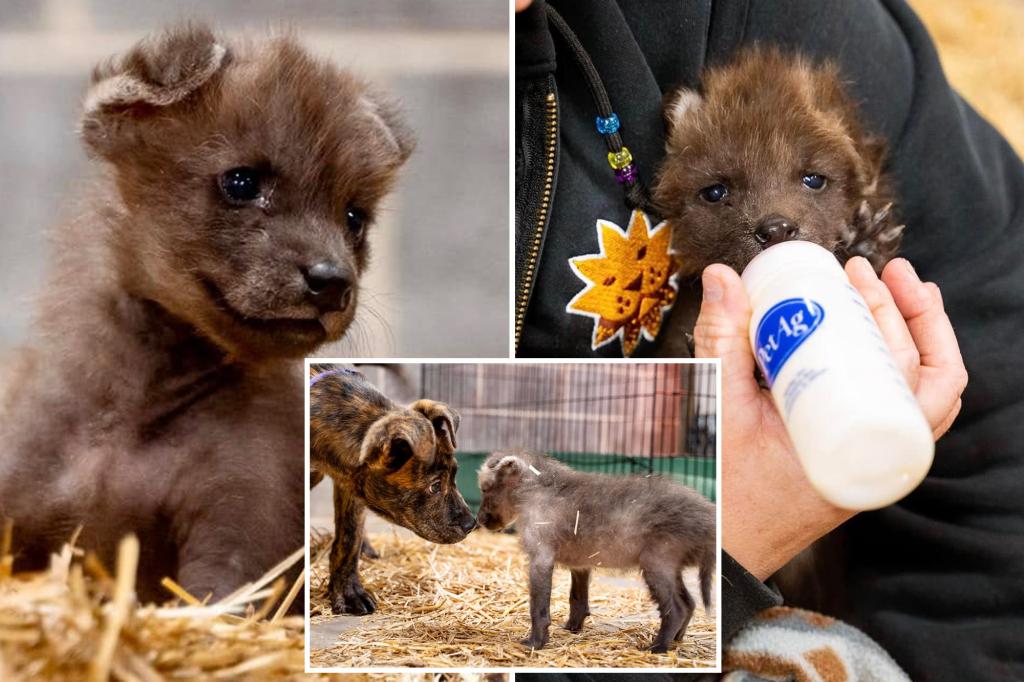The heartwarming story of Amora, a newly orphaned maned wolf pup, and Slinky, a recently bereaved young dog, exemplifies the power of interspecies companionship and the innovative approach of animal care professionals in fostering social and emotional well-being in captive animals. Amora’s mother, Layla, unexpectedly passed away shortly after giving birth at the Sedgwick County Zoo in Kansas, leaving the vulnerable pup without the crucial maternal care necessary for proper development. Recognizing the importance of social interaction for young wolves, the zoo staff embarked on a unique mission to find Amora a companion. Serendipitously, the Kansas Humane Society (KHS), on the very same day, received a young brindle mix named Slinky who had recently lost his sister to adoption, leaving him lonely and despondent. The stars aligned, and the zoo reached out to the KHS, hoping to provide Amora with a much-needed friend and offer Slinky a new home.
The introduction of Amora and Slinky marked the beginning of an unlikely but deeply beneficial friendship. Despite Amora’s initially spirited and somewhat “spicy” personality, Slinky’s playful and gentle nature proved to be a calming influence. Their interactions provided crucial social stimulation for Amora, promoting her natural wolf instincts and helping her develop into a well-adjusted individual. Slinky, in turn, found solace and companionship in Amora, overcoming his own grief and thriving in his new environment. This unique pairing demonstrates the surprising adaptability and emotional depth of animals, transcending species boundaries to forge meaningful connections. Their story underscores the significance of considering emotional and social needs, alongside physical well-being, in animal care, particularly for those in captivity.
The arrangement between Amora and Slinky is not a permanent one. As Amora matures, she will eventually be integrated with other maned wolves, her own species. However, Slinky’s future is secure. He has won the hearts of the zoo staff, and one employee has already committed to adopting him once his role as Amora’s companion is complete. This thoughtful planning ensures that neither animal will experience further disruption or loss once their shared chapter closes. Slinky’s ongoing presence within the zoo community highlights the dedication of the staff to the well-being of all animals in their care, extending beyond the exotic and endangered species to encompass the domestic animals whose lives intersect with theirs.
The practice of pairing animals with companion dogs, although seemingly unconventional, is a well-established technique employed by zoos worldwide, particularly with cheetahs. These naturally solitary and often anxious animals benefit immensely from the calming presence of a canine companion. The dog acts as an emotional support animal, providing comfort and reducing stress, which in turn promotes healthy behavior and overall well-being. The cheetah-dog pairing is a testament to the understanding of animal behavior and the creative application of interspecies dynamics to improve the lives of captive animals.
The Cincinnati Zoo, for example, has successfully integrated companion dogs into the lives of their resident cheetahs. These dogs, often Labradors, offer companionship and playfulness, easing the cheetahs’ anxiety and promoting a sense of security. The bond formed between cheetah and dog can be remarkably strong, demonstrating the capacity for interspecies friendship to flourish even in seemingly disparate species. The dogs act as emotional anchors, helping the cheetahs navigate the complexities of captive life and providing a sense of normalcy.
Another striking example is the enduring friendship between Kumbali the cheetah and Kago the Labrador at the Richmond Metro Zoo. Their nearly decade-long companionship highlights the sustained benefits of such pairings. Kago’s protective instincts often manifest in him positioning himself closest to the viewing area, acting as a buffer between Kumbali and the observing public, showcasing the depth of their bond and the dog’s inherent understanding of his friend’s needs. These stories, from Amora and Slinky to Kumbali and Kago, illuminate the power of interspecies companionship in enriching the lives of captive animals, providing emotional support, reducing stress, and ultimately contributing to their overall health and well-being. They also highlight the dedication and innovative approaches employed by zoos and animal care professionals in ensuring the highest quality of life for the animals entrusted to their care.

